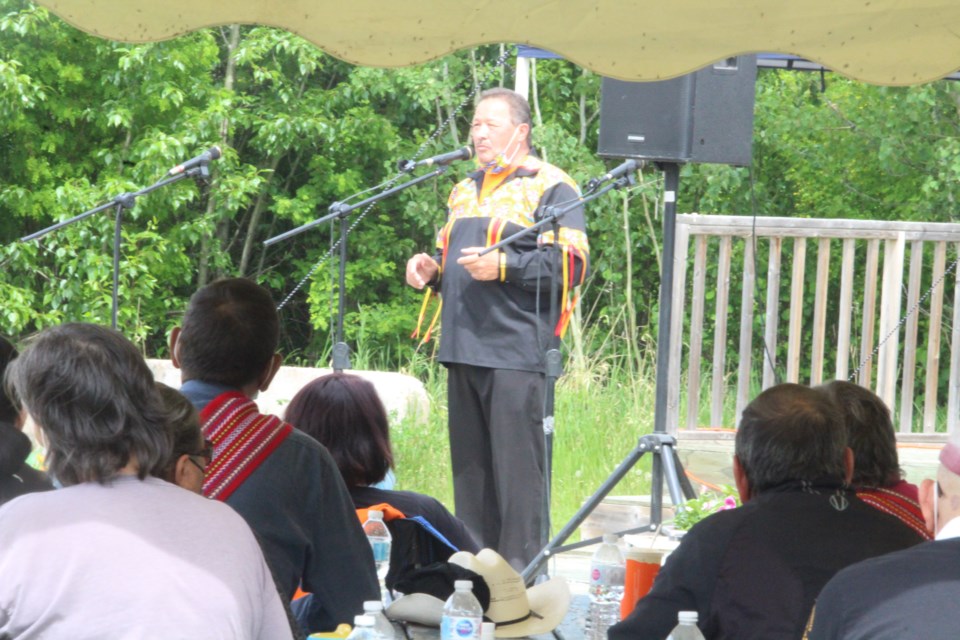Members and leadership of the Metis Nation of Alberta Region One held a memorial this past Wednesday afternoon at the Lac La Biche Mission for the 215 children that were found in unmarked graves at the Kamloops Residential School. The event was also to pay tribute to the other victims of the residential school system and the survivors who still suffer the effects.
The Mission was previously a Residential School which many elders in the Lac la Biche area attended at one point in their lives.
Jim Cardinal, the President of Métis Nation Region One, spoke to the crowd of about 200, explaining why he believed the memorial had to be held there.
“We have to have it here, because there are souls here that have been wanting to hear this today,” said Cardinal, “I had four dreams, and in each of them, I saw a chair at The Mission.”
The memorial had many guest speakers, dancing, singing, smudging and prayers before a lunch was served to those who attended. Each guest stood during the 215 seconds of silence to remember the children that were lost to the Residential Schooling system.
Some elders spoke of their experiences while attending school at the Lac La Biche Mission and other residential and community schools across the region. Across Canada from the early 1800s to as recently as 1996, more than 130 residential schools were in operation, taking in more than 150,000 Indigenous students. The mandate of the schools, run mostly by the Catholic Church and governed by the Canadian government, was to assimilate the Indigenous children, removing their culture and language. Based only on completed records, federal statistics estimate that 5,000 students died while in the residential school system. Most presenters at Wednesday's event believed that number to be much higher.
It was an emotional day for many but an important reminder that, once again, Canada cannot ignore this any longer, said Cardinal.
“We have to find the rest of the kids, this can’t stop here,” said Cardinal, “This is only the beginning of where we are going and what’s going to be done.”
In 2009, the Truth and Reconciliation Commission of Canada was rejected funding of $1.5 million when they had requested the federal government to identify burial sites of Indigenous children at Residential Schools.
Immediately following the discovery of the remains on the site of the former Kamloops residential school, Canada's Minister of Crown-Indigenous Relations, Carolyn Bennett, announced that the federal government is ready to distribute $27 million in pre-announced funding to assist Indigenous communities in locating and memorializing children who died at residential schools.
Just a few hundred feet from the current entrance of the Lac La Biche Mission site, now a provincial and federal historic site, the Mission Cemetery houses mass burial site. A sign at the cemetery says the unmarked grave, indicated only be a large circle of stones is the resting place of many children from the Mission school who died during outbreaks of influenza or tuberculosis during the school years.
Daniel Cardinal, the Vice President of the Métis Nation of Alberta, spoke about the horrors of residential schools at Wednesday’s event.
“I want to point out that the real objective of Residential Schools was to beat the Indian out of the child, to strip him of his identity, his culture and his language,” said Cardinal.
Speaker after speaker at the afternoon event told their own personal stories of direct and intergenerational trauma caused by the residential school system. The stories, though tragic, are hoped to increase the awareness and force changes and proper reconciliation for what many consider the attempted genocide of the Indigenous community.
Cardinal said the fight remains and the passion to find answers, find truth and try to heal is stronger than ever.
“We are still very much here, by the strength of our survivors who told their stories, who refused to give up,” said Cardinal.
Officials from the Lac La Biche Mission Historic Site are in full support of examining the lakeside property for indications of more grave-sites. Municipal officials and Indigenous leaders from the region have pledged to work together to find solutions and push the provincial and federal governments to act on the continuing crisis.
The Metis Nation of Alberta Region One area spans from Highway 28 north to the Northwest Territories border, west to Athabasca and east to the Saskatchewan border. Provincial and regional MNA leaders say they will continue to collect stories, raise awareness and challenge all levels of government for long-needed assistance.
Despite COVID-19 restrictions that were in place at the time of the event, municipal officials said as long as social distancing was observed, enforcement of the Public Health Orders would be overlooked.
Read more from LakelandToday.ca



